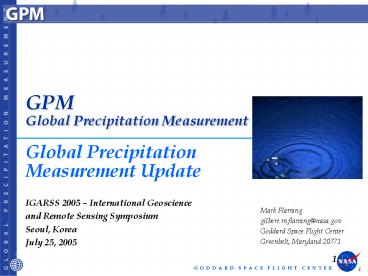NASA - PowerPoint PPT Presentation
1 / 23
Title:
NASA
Description:
NASA – PowerPoint PPT presentation
Number of Views:68
Avg rating:3.0/5.0
Title: NASA
1
GPMGlobal Precipitation Measurement
Global Precipitation Measurement Update IGARSS
2005 International Geoscience and Remote
Sensing Symposium Seoul, Korea July 25, 2005
Mark Flaming gilbert.m.flaming_at_nasa.gov Goddard
Space Flight Center Greenbelt, Maryland 20771
2
- Mission Overview
- Core Spacecraft Instruments
- Core Spacecraft
- Ground Validation
- Mission Status
3
- Mission Overview
4
Mission Overview
- The GPM Mission consists of multiple
international partner satellites working in
concert to cover the globe with precipitation
measurements (primarily through microwave
radiometer measurements).
- Core Satellite
- TRMM-Like S/C, NASA
- H2-A Launch, JAXA
- Non-Sun Synchronous Orbit
- 65 Inclination
- 400 km Altitude
- Dual Frequency Radar, JAXA
- Ku Ka Bands
- 5 km Horizontal Resolution
- 250 m Vertical Resolution
- Multifrequency Radiometer, NASA
- 10.65, 18.7, 23.8, 36.5, 89 GHz VH
- Constellation Satellites
- Dedicated Small or Pre-existing Experimental
Operational Satellites with PMW Radiometers - Revisit Time
- 3-Hour goal
- Sun- Non-Sun- Synch Polar Orbits
- 600 km Altitude
- Global Precipitation Processing Center
- Produces Global Precipitation Data Product
Streams Defined by GPM Partners
- Ground Validation Sites
- Selected Globally Distributed Ground- Based
Supersites (Multiparameter radar, up looking
radiometer/radar/profiler, raingages,
disdrometers) - Dense Regional Raingage Networks
5
Mission Overview (continued)
6
Mission Overview (continued)
- NASA is responsible for
- Key elements of the Core observatory (spacecraft,
ground system, and the GMI instrument) - One constellation spacecraft and its ground
system - Precipitation Processing System (PPS)
- Two Ground Validation Supersites
- JAXA is responsible for
- The Ka-band Precipitation Radar (to fly on the
Core spacecraft) - The Ku-band Precipitation Radar (to fly on the
Core spacecraft) - The launch vehicle for the Core spacecraft
- Other US agencies (i.e. DOD NOAA)
- Will contribute radiometer rainfall measurement
data streams from existing and planned satellites
for ingest into the to PPS data products - Other international partners
- Invited to support GPM by providing spacecraft,
instruments, rain gauge networks, ground
validation facilities, etc.
7
Mission Overview (continued)
Revisit Times vs. Number of Satellites
- .
Revisit Times vs. Number of Satellites
Refer to scale on left
Refer to scale on right
Percent Sampled Bins and Global Mean Revisit Time
vs. Number of Satellites
8
Mission Overview (continued)
Evolution of Precipitation Measurement
Capabilities
SSM/I ERA
GPM ERA
TRMM ERA
Systematic Measurement ERA
EOS ERA
Partner
AMSR F/O
EuroGPM-1
Adjunct Base
US Const
AQUA AMSR
GPM Core GMI DPR
TRMM TMI PR
NPOESS CMIS
DMSP SSM/I
NPOESS CMIS
DMSP SSMIS
DMSP SSM/I
DMSP SSMIS
NPOESS CMIS
90
98
14
12
10
02
96
00
88
92
94
04
06
08
16
18
Years
Breakthrough
GPM Precursor Experiment
Science Quality Tropical Rainfall Measurements
Reliable Radiometric Rainfall Estimation
Mature Global Precipitation Observing System
High Spatial-Temporal Resolution Calibrated GPM
Demo
9
Mission Overview (continued)
10
- Core Spacecraft Instruments
11
Core Spacecraft Instruments
- Dual-requency (Ka Ku) Precipitation Radar
(DPR) - Nadir Viewing
- View to cold space
- Electronic cross track scan
- GPM Microwave Imager (GMI)
- Conical scan
- Off-nadir viewing (48.5º)
- 1.2 m aperture
- Hot Cold calibration each scan
12
Core Spacecraft Instruments
1.0 m
KaPR
Dual-frequency Precipitation Radar (DPR)
2.4m
GPM Microwave Imager (GMI)
KuPR
1 m
2.4m
Approximately to scale
13
JAXA/NICT Dual Frequency (13.6, 35.55 GHz)Ku-Ka
Band Precipitation Radar (DPR)
Core Spacecraft Instruments
Measurable range by 35GHz radar
Measurable range by 14GHz radar
- DPR radar will
- Measure intense rain in tropics
- Weak rain snow in mid/ high-latitudes
- DSD using differential reflectivity
Rainrate Frequency
mid- high- latitude rain snow
tropical rain
strong rain
weak rain snow
Rainrate
new measurable range by addition of 35GHz radar
14
Core Spacecraft Instruments
Scan Geometry Conical Scanning Receiver
Total Power Polarization Linear V and H
Antenna Real Aperture (offset-parabolic
antenna with multiple feed horns)
GPM Microwave Imager (GMI)
15
- Core Spacecraft
16
Core Spacecraft
Spacecraft Design Requirements Launch Mass
3000- 3200 kg Payload Mass 840 kg Power 1,650
W Design Life 3 years Compatible with Launch on
H-IIA
GMI Microwave Imager
13.6GHz radar (Similar to TRMM PR phased array)
35.5GHz radar (phased array)
Notional Concept for GPM Core Spacecraft
17
Core Spacecraft (continued)
- The GPM Core Spacecraft will be launched on board
the H-IIA launch vehicle
GMI
KuPR
KaPR
18
- Ground Validation
19
Ground Validation
20
- Mission Status
21
Mission Status
- Significant Accomplishments
- Formulation Memorandum of Agreement between NASA
and Japanese Aerospace and Exploration Agency
(JAXA) recently signed - GPM Microwave Imager (GMI) Contract for
instrument design, fabrication, and test recently
awarded - RSDO Spacecraft Study Contracts
- Phase A Studies by 3 vendors completed
- Proposals for Phase B Follow-on Study contracts
under review - DPR
- KuPR engineering model in development
- KaPR engineering model undergoing testing
- 5th International GPM Planning Workshop
- Scheduled to meet in Tokyo, Japan during
November, 2005
22
GPM
23
- Questions?































